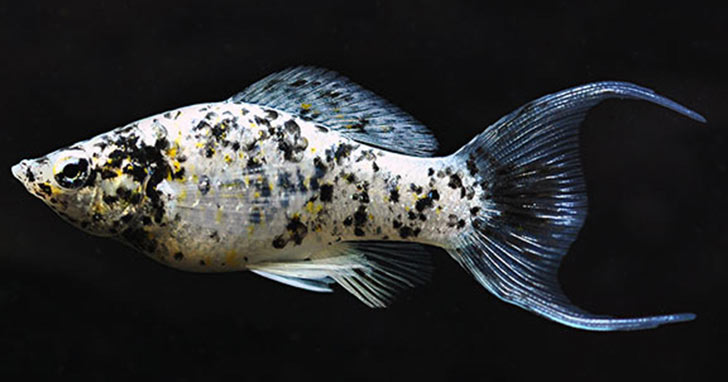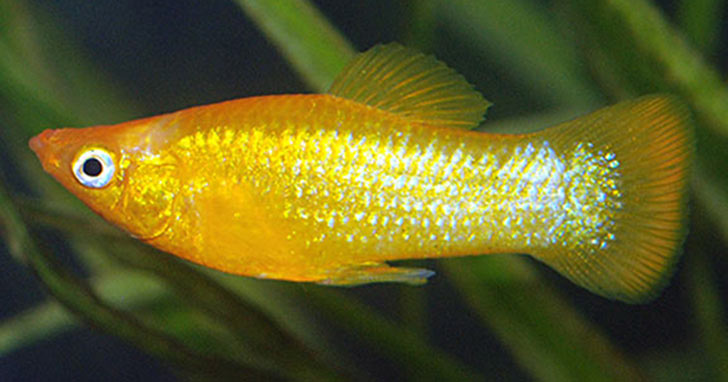Mollies thrive in water temperatures between 75°F and 80°F. Maintaining stable temperatures ensures their health and vitality.
Mollies, popular freshwater fish, require specific water conditions to thrive. Their ideal water temperature ranges from 75°F to 80°F. This range mimics their natural tropical habitat, promoting optimal health and activity levels. Temperature stability is crucial for mollies, as fluctuations can cause stress and illness.
Investing in a reliable aquarium heater helps maintain a consistent environment. Regular monitoring with an accurate thermometer ensures the water stays within the ideal range. Providing proper water conditions, including the right temperature, supports mollies’ overall well-being and longevity. Keeping mollies in their preferred temperature range ensures a thriving and vibrant aquarium.

Credit: www.aquariumcoop.com
Ideal Water Temperature For Mollies
Mollies are popular among aquarium enthusiasts. They are hardy and colorful fish. To keep them healthy, the water temperature must be just right.
Factors Influencing Water Temperature
Several factors affect the ideal water temperature for mollies:
- Tank Size: Larger tanks retain heat better than smaller ones.
- Room Temperature: The temperature of the room affects the water temperature.
- Heater Quality: A reliable heater ensures consistent water temperature.
- Water Movement: High water flow can disperse heat unevenly.
Temperature Range For Optimal Health
Mollies thrive in a specific temperature range. Here is the ideal temperature range for mollies:
| Temperature Range | Condition |
|---|---|
| 72°F – 78°F (22°C – 26°C) | Optimal Health |
| 68°F – 71°F (20°C – 21°C) | Acceptable |
| 79°F – 82°F (26°C – 28°C) | Acceptable |
| Below 68°F (20°C) | Too Cold |
| Above 82°F (28°C) | Too Warm |
Maintaining this range is crucial. It ensures your mollies live a long and healthy life.
Effects Of Incorrect Water Temperature
Mollies thrive in specific water temperatures. Incorrect water temperature affects their health. Keeping the water too cold or too warm leads to stress.
Stress And Immune Response
Stress harms mollies. It weakens their immune system. This makes them prone to diseases.
Cold water slows their metabolism. It reduces their activity levels. Warm water increases their metabolism. This makes them hyperactive and stressed.
Both conditions are harmful. Mollies need stable water temperature. This keeps their immune system strong.
Reproductive Challenges
Incorrect water temperature affects molly reproduction. Cold water delays breeding. It reduces their fertility.
Warm water speeds up their breeding cycle. It leads to poor egg quality. This results in fewer healthy fry.
Ideal water temperature is crucial. It ensures successful breeding. Keep the temperature between 75-80°F for optimal reproduction.
Monitoring Water Temperature
Monitoring water temperature is crucial for the health of Mollies. These fish thrive best in specific temperature ranges. Maintaining the right temperature ensures their well-being.
Tools For Temperature Measurement
Several tools can help you monitor water temperature effectively. Choose the right tool based on your needs:
- Thermometers: Digital or analog thermometers provide accurate readings.
- Heaters: Heaters with built-in thermostats ensure consistent temperatures.
- Temperature Controllers: These devices help maintain a stable temperature.
Use the table below to compare the tools:
| Tool | Accuracy | Cost |
|---|---|---|
| Digital Thermometer | High | Moderate |
| Analog Thermometer | Moderate | Low |
| Heater with Thermostat | High | High |
| Temperature Controller | Very High | High |
Maintaining Consistent Temperatures
Consistency is key to a healthy aquarium. Here are steps to maintain stable temperatures:
- Check Daily: Monitor the temperature every day.
- Use a Heater: Ensure the heater is functioning well.
- Avoid Drafts: Place the tank away from windows and vents.
- Regular Maintenance: Clean the heater and thermometer regularly.
Following these steps helps keep your Mollies happy and healthy.
Adjusting Water Temperature For Mollies
Adjusting Water Temperature for Mollies is crucial for their health. Mollies thrive in specific temperature ranges. Maintaining this range ensures their well-being.
Heating Solutions
Keeping the water warm can be easy. Use an aquarium heater to maintain temperatures. Set the heater between 75°F to 80°F. This range is perfect for mollies.
Place the heater in a spot with good water flow. This helps distribute heat evenly. Always use a thermometer to check the temperature. Digital thermometers give accurate readings.
Cover your aquarium with a lid. This helps retain heat. It also prevents rapid temperature drops. Ensure your heater has an automatic shut-off feature. This prevents overheating.
Cooling Techniques
Warm climates can heat your tank water. Use a fan to cool the water. Position the fan to blow across the water surface. This promotes evaporation and cooling.
Another method is using frozen water bottles. Place these bottles in the tank. They slowly lower the water temperature. Always monitor the temperature with a thermometer.
Keep your aquarium away from direct sunlight. This prevents unwanted heating. Use an aquarium chiller for precise control. It maintains the desired temperature range.
| Temperature Control Method | Type | Ideal Temperature Range |
|---|---|---|
| Aquarium Heater | Heating | 75°F – 80°F |
| Fan | Cooling | Reduces by evaporation |
| Frozen Water Bottles | Cooling | Temporary cool |
| Aquarium Chiller | Cooling | Maintains set temperature |
Seasonal Temperature Variations
Understanding seasonal temperature variations is crucial for keeping mollies healthy. Mollies are tropical fish and thrive in stable water temperatures. Changes in seasons can affect water temperature, and knowing how to manage these changes ensures your mollies stay happy and healthy.
Summer Care Tips
During summer, water temperatures can rise significantly. It’s important to keep the water temperature within the safe range for mollies, which is between 75°F and 80°F (24°C to 27°C).
- Use a Thermometer: Regularly check the water temperature using an aquarium thermometer.
- Air Conditioning: If the room temperature is high, use air conditioning to maintain a cooler environment.
- Aquarium Fans: Install aquarium fans to help cool down the water.
- Partial Water Changes: Perform partial water changes with cooler water to help reduce the temperature.
Winter Care Strategies
Winter brings colder temperatures, which can drop the water temperature below the ideal range for mollies. Keeping the water warm is essential to prevent stress and disease.
- Aquarium Heater: Use a reliable aquarium heater to maintain a consistent temperature.
- Check Heater: Regularly check the heater to ensure it is functioning properly.
- Insulate the Tank: Use tank insulation or place the aquarium in a warmer part of the house.
- Cover the Tank: Use a tank cover to retain heat and reduce temperature fluctuations.
By following these summer care tips and winter care strategies, you can ensure your mollies thrive throughout the year. Proper temperature management is key to their health and well-being.

Credit: www.liveaquaria.com
Acclimating Mollies To New Temperatures
Acclimating mollies to new water temperatures is crucial for their health. Sudden changes can stress them, causing illness or even death. Follow this guide to ensure a smooth transition for your mollies.
Step-by-step Acclimation Process
- Float the Bag: Place the bag with mollies in your tank for 15 minutes. This allows the water temperature inside the bag to match the tank’s temperature.
- Add Tank Water: Open the bag and add a cup of tank water every five minutes. Do this for 20-30 minutes to help mollies get used to the new water chemistry.
- Release the Mollies: Use a net to gently transfer the mollies into the tank. Avoid pouring the bag water into the tank to prevent contamination.
Common Acclimation Mistakes
- Skipping the Floating Step: Not floating the bag can shock mollies due to sudden temperature changes.
- Adding Water Too Quickly: Adding tank water too fast can stress mollies. Always add water gradually.
- Ignoring Water Chemistry: Only consider temperature changes. Water chemistry also plays a vital role.
- Using Contaminated Water: Pouring bag water into the tank introduces potential contaminants. Always use a net to transfer mollies.
By following these steps and avoiding common mistakes, you can ensure a smooth acclimation process for your mollies. Happy fishkeeping!
Water Temperature And Mollies’ Health
Mollies are colorful and lively fish. They need the right water temperature for good health. The ideal temperature range for mollies is between 72°F to 82°F. Keeping the water temperature within this range is crucial. It helps mollies stay healthy and active. Deviations can cause stress and health problems.
Signs Of Temperature Stress
Temperature stress in mollies shows specific signs. Look for these symptoms:
- Gasping for air at the water surface
- Clamped fins
- Loss of appetite
- Erratic swimming patterns
- Color fading
These signs indicate that the water temperature is not suitable. Adjust the temperature immediately to prevent further stress.
Long-term Health Implications
Consistent exposure to incorrect water temperatures can harm mollies. Here are some long-term health issues:
| Temperature Issue | Health Implication |
|---|---|
| Too Cold | Slowed metabolism, weakened immune system |
| Too Hot | Increased stress, reduced oxygen levels |
Maintaining a stable water temperature is vital. It prevents these long-term health issues and ensures mollies thrive.

Credit: www.liveaquaria.com
Advanced Tips For Breeders
As a dedicated molly breeder, achieving optimal breeding conditions is key. Water temperature plays a crucial role in the health of both adult mollies and their fry. Understanding advanced tips for managing water temperature can significantly improve breeding success.
Breeding Temperature Ranges
Maintaining the right water temperature is vital for breeding mollies. The ideal temperature range for breeding is between 78°F and 82°F (25.5°C – 27.7°C). Temperatures outside this range may stress the fish and affect their ability to breed.
Consider using a reliable aquarium heater to keep the water temperature stable. Sudden temperature fluctuations can be harmful. Use a thermometer to monitor the temperature regularly. Consistent water temperature ensures a healthy breeding environment.
Managing Fry Temperature Needs
Newly hatched fry have different temperature needs. They thrive best at a temperature of 80°F (26.6°C). Lower temperatures can slow their growth and make them susceptible to diseases.
To manage fry temperature needs, consider the following tips:
- Use a separate tank for fry with a dedicated heater.
- Keep the water clean and well-oxygenated.
- Monitor the temperature daily to avoid fluctuations.
Here’s a quick reference table for optimal temperatures:
| Life Stage | Optimal Temperature |
|---|---|
| Breeding Adults | 78°F – 82°F (25.5°C – 27.7°C) |
| Fry | 80°F (26.6°C) |
Ensure you provide the best conditions for your mollies. Proper water temperature management is essential for successful breeding and healthy fry development.
Conclusion
Maintaining the right water temperature for mollies is crucial. Aim for a range between 72°F and 78°F. This ensures their health and vitality. Regularly monitor water conditions to keep mollies thriving. Proper care leads to vibrant, happy fish. By following these guidelines, your mollies will enjoy a healthy, balanced environment.
